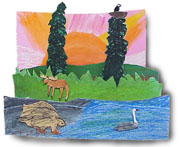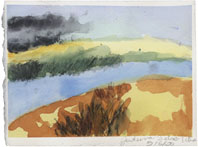 EXPANSION
OF ILLUSTRATING SKILLS THROUGH THE VISUAL ARTS EXPANSION
OF ILLUSTRATING SKILLS THROUGH THE VISUAL ARTS
 The
visual art component was added in the third year of the project to illustrate
events and activities that cannot be photographed. The primary goal
of the visual arts component is to enhance the web site with drawings
and paintings of historical places where Minto people have lived, camped
and experienced their subsistence life-style. The
visual art component was added in the third year of the project to illustrate
events and activities that cannot be photographed. The primary goal
of the visual arts component is to enhance the web site with drawings
and paintings of historical places where Minto people have lived, camped
and experienced their subsistence life-style.
In order for the students to develop "a sense of
place" in the visual art world, they will view art and learn about
artists in other parts of the world to see how they include their own
cultural heritage in their art.
Philosophy
Art is a universal language which crosses time and cultures.
The Minto Mapping Project can use the visual art to reflect and preserve
important cultural events of the past, and those events happening now.
The growth and development of each individual can be
enriched through art since it celebrates uniqueness, self- expression
and diversity. Art provides a means for appreciating, valuing and respecting
ourselves and others.
Mission
 It
is the intent of the visual art segment of the project to provide the
students of Minto with a broad scope of art experiences. It will give
diverse exposure to media, concepts and activities to enable them to
record what is happening around them. Students will use their art to
illustrate the stories the Elders tell and to draw the historical sites
and landmarks. Their experiences will include some formal training in
the visual arts, as well as the local folk art taught by the Elders.
What they accomplish can be scanned to the web site to enhance the project
and give it meaning to themselves as well as the Elders. It
is the intent of the visual art segment of the project to provide the
students of Minto with a broad scope of art experiences. It will give
diverse exposure to media, concepts and activities to enable them to
record what is happening around them. Students will use their art to
illustrate the stories the Elders tell and to draw the historical sites
and landmarks. Their experiences will include some formal training in
the visual arts, as well as the local folk art taught by the Elders.
What they accomplish can be scanned to the web site to enhance the project
and give it meaning to themselves as well as the Elders.
Traditional Folk Art of Minto
Students need to identify the folk art popular in their
village of Minto both past and present. This would include beading,
carving, clothing design, bark basket making and others. Folk art is
defined as the art forms done by artists of an ethnic group without
formal art education. Folk art is usually passed down from one generation
to another.
Students need to investigate the origins of design and
patterns used in the local folk art, and understand the significance
of these art forms in their lives.
Elders need to pass on information and teach the students
about their traditional folk art. This should include any historical
importance, along with specific techniques and instruction in each of
the art forms.
Visual Art Experiences
 Producing
art must include some building block experiences both in the concepts
taught and the media the students learn to use. Producing
art must include some building block experiences both in the concepts
taught and the media the students learn to use.
Drawing Concepts
- Introduce sketching and contour line drawing.
- Draw from observation.
- Use forms and light to study shading.
- Discuss and use perspective to give depth.
Media for Drawing
pencils, charcoal, oil pastels, and the ink pen
Painting Concepts
- Discuss color theory: This
would include primary colors, secondary colors, complementary colors,
analogous colors, and monochromatic color schemes.
- Learn how to mix secondary colors from the primary
colors.
- Discover how color combinations can give a mood
to a painting.
- Discuss value and contrast using a monochromatic
color scheme.
- Learn watercolor techniques such as wet on wet, wet
on dry, washes, and resists.
- Examine different painting styles of artists going
from realism, impressionism, to abstract. Compare the varied styles
of folk art in Minto.
- Combine media using both painting and drawing techniques.
Oil pastels will create a resist and ink pens can enhance a painting
with detail
|
|
Cultural
Standards
Students
A6, B1—2,
C3, D1, E8
Educators
A2—4, A6,
B1, B3, B5, C2—3, E2—3, E5
Curriculum
A1—5, B1,
C4—6, D2, E1
Schools
A1—2, B2
Communities
E2, F2—3
|

